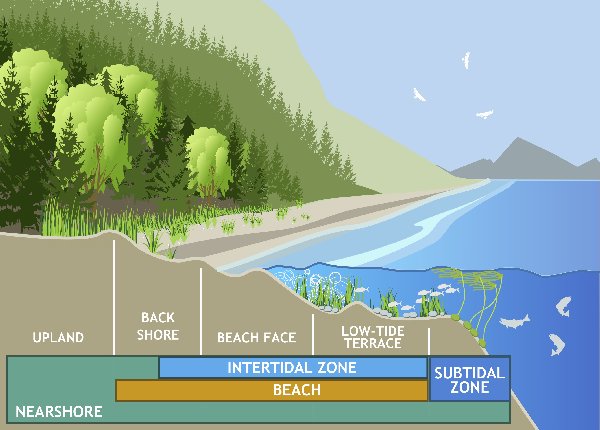Nearshore Ecosystem
What is a Nearshore Ecosystem?
The nearshore includes the area from the deepest part of the photic zone (layers of water exposed to sunlight) landward to the top of shoreline bluffs, or in estuaries upstream to the head of tidal influence.

The Nearshore includes four basic zones.
- the subtidal which is always under water and where vegetation like eelgrass and kelp grow
- the intertidal zone which is underwater when the tide is in. When the tide is low this zone is exposed
- the backshore zone, beyond the reach of normal waves and tides. It includes native grasses and other perennials, logs and sometimes boulders, and is also often the site of dunes and back-barrier wetlands
- the upland area that consists of shrubs and trees. This area is often also called the marine riparian.
Why the nearshore is important
On different types of beaches, these zones will look different. For example a sandy beach will have a low, flat and sandy intertidal zone, but a rocky beach will have a rocky intertidal. Much of the information we will focus on will apply to the sandy beaches as they are prevalent in this area.
The nearshore ecosystem is complex. Because of certain habitats, we will find certain species at the low end of food chains, which then determine the animals, birds and fish that are further up the food chains. There are often connections between food chains.
In order to understand and manage the nearshore, we need to simplify the picture. For this reason we determine the health of the nearshore ecosystem by mapping and monitoring specific parts of the ecosystem, called indicators. We use five indicators of nearshore health
Together these zones work to stabilize our shorelines, provide important habitat for many animals, fish and birds. The nearshore also gives us many ecosystem services which include clean air and water; storm and flood management; adaptation to climate change; food sources including a fishing industry; tourism industry activities like whale watching, birding, kayaking, swimming, walking or playing on warm, safe beaches; and a general quality of life.
Five indicators of nearshore health
The nearshore ecosystem is complicated and so in order to determine if it is healthy or not, managers must choose some indicators to measure, that together, can tell them if the nearshore is working or not. We will use the same five nearshore indicators as those used in Puget Sound:
- riparian health
- shoreline modifications
- forage fish populations
- eelgrass and kelp mapping and monitoring
- use of nearshore by juvenile salmon.